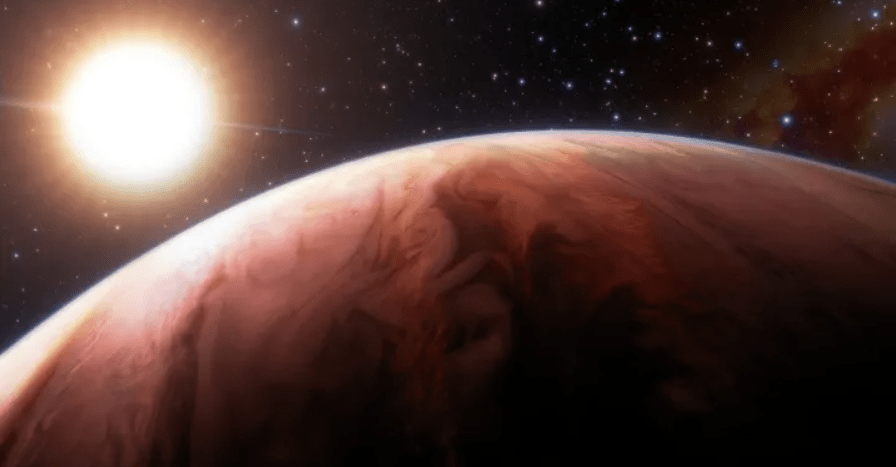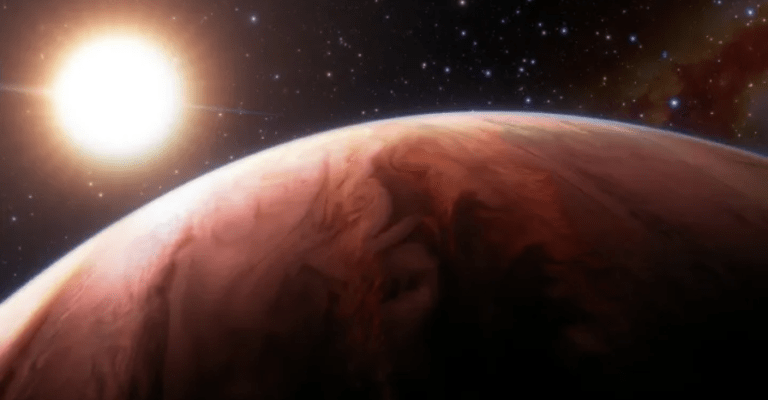Webb Space Telescope Detects Quartz Crystals 1,300 Light-Years Distant from Earth
Study abstract:
Clouds are prevalent in many of the exoplanet atmospheres that have been observed to date. For transiting exoplanets, we know if clouds are present because they mute spectral features and cause wavelength-dependent scattering. While the exact composition of these clouds is largely unknown, this information is vital to understanding the chemistry and energy budget of planetary atmospheres. In this work, we observe one transit of the hot Jupiter WASP-17b with JWST’s Mid-Infrared Instrument Low Resolution Spectrometer and generate a transmission spectrum from 5 to 12 μm. These wavelengths allow us to probe absorption due to the vibrational modes of various predicted cloud species. Our transmission spectrum shows additional opacity centered at 8.6 μm, and detailed atmospheric modeling and retrievals identify this feature as SiO2(s) (quartz) clouds. The SiO2(s) clouds model is preferred at 3.5–4.2σ versus a cloud-free model and at 2.6σ versus a generic aerosol prescription.

Webb conducted atmospheric observations of the searing gas giant for an extensive duration of nearly 10 hours.
Since its launch, the James Webb Space Telescope (JWST) has transformed our comprehension of distant celestial realms. Recently, Webb has identified the existence of minute quartz nanocrystals within the upper atmospheric clouds of the searing gas giant, WASP-17 b.
Situated approximately 1,300 light-years away from Earth, WASP-17 b belongs to the category of hot Jupiter exoplanets. This exoplanet completes a single orbit around its parent star, WASP-17, in a mere 3.7 Earth days. Due to its proximity to the star, WASP-17 b is exposed to intense radiation and extreme temperatures.
As per the official announcement, this marks the inaugural detection of silica (SiO2) particles within the atmosphere of an exoplanet. This discovery carries significant implications for our understanding of the formation and evolution of exoplanetary cloud systems.
David Grant, a researcher at the University of Bristol in the United Kingdom and the lead author of the study, expressed their excitement, stating, ‘We were delighted! We were aware, from previous Hubble observations, that there were aerosols—tiny particles that constitute clouds or haze—in the atmosphere of WASP-17 b, but we did not anticipate that these aerosols would be composed of quartz.
Existence of quartz
The presence of quartz, a specific type of silicate, is noteworthy. Silicates are a group of minerals abundant in silicon and oxygen, widely distributed throughout our solar system, forming the primary composition of Earth, the Moon, and various other rocky celestial bodies. They are also prevalent in various forms across galaxies.
The types of silicate minerals identified in the atmospheres of exoplanets can vary. What makes this discovery remarkable is that, in contrast to previous observations of silicate particles in exoplanetary and brown dwarf atmospheres, the recently uncovered silicate grains are primarily composed of quartz.
Previous research had identified these grains as consisting of magnesium-rich silicates such as olivine and pyroxene.
Hannah Wakeford, a co-author from the University of Bristol, explained, “We initially expected to observe magnesium silicates. However, what we are actually seeing are likely the fundamental particles required to form the larger silicate grains detected in cooler exoplanets and brown dwarfs, essentially the ‘seeds.'”
The presence of silicates in exoplanet atmospheres is captivating because it provides insights into the mechanisms at play in these distant alien worlds.
Webb’s extended surveillance
The research team utilized the JWST’s Mid-Infrared Instrument (MIRI) to observe WASP-17 b during its transit across its host star. Webb conducted these observations over an extended period of nearly 10 hours. This prolonged monitoring allowed the accumulation of a substantial dataset comprising more than 1,275 measurements of brightness in the mid-infrared spectrum.
The data disclosed that the presence of quartz crystals originates within the exoplanet’s atmosphere itself rather than being swept up from a rocky surface.
“WASP-17 b experiences extremely high temperatures, roughly around 1,500 degrees Celsius (2,700 degrees Fahrenheit), and the atmospheric pressure at the altitude where these crystals form is only about one-thousandth of what we encounter on Earth’s surface. Under these conditions, solid crystals can directly emerge from gaseous form without transitioning through a liquid phase first,” as elucidated by Grant.
The research team acknowledges that accurately determining the quantity of quartz and the extent of cloud coverage is a challenging endeavor.
The exoplanet’s atmosphere primarily consists of hydrogen and helium, with minor amounts of water vapor and indications of carbon dioxide and other chemical compounds.
Scientists often estimate the cloud composition as a means to gain further insights into the prevailing atmospheric conditions on exoplanets. This data can offer crucial information about the planet’s chemistry, geological history, and its potential suitability for habitation.
The findings were published in the Astrophysical Journal Letters.
This article is republished from InterestingEngineering under a Creative Commons license. Read the original article.
Do not forget to share your opinion with us to provide you with the best posts !




0 Comments